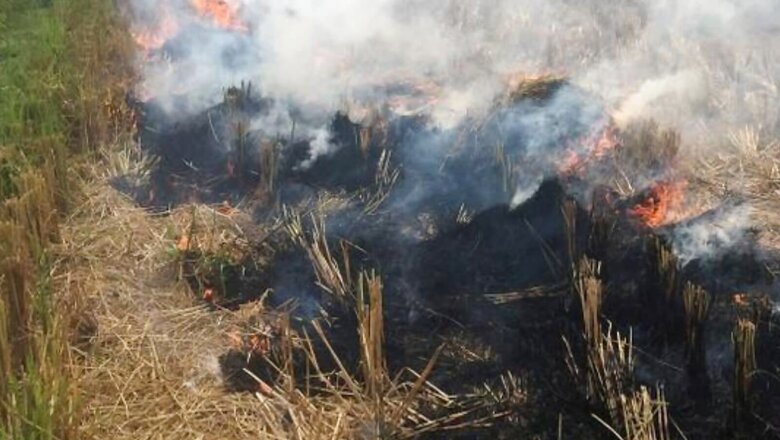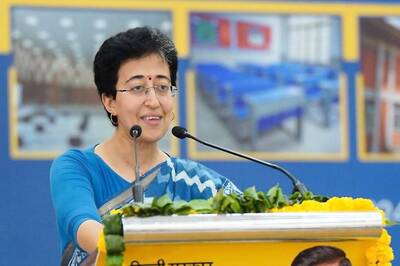
views
To reduce stubble burning, a major concern for the National Capital Region (NCR) every winter, it has been made mandatory for thermal power plants to use biomass pellets as 5-7% of their fuel mix, finance minister Nirmala Sitharaman announced in her Union budget speech on Tuesday.
With the onset of winter, farm fires become rampant in northern Indian states, particularly in Punjab, Haryana and western Uttar Pradesh. Burning of crops worsens the air quality in the region during winter and contributes to the alarming pollution levels in the neighboring Delhi.
Pellets are mixed with coal to generate electricity. India’s power plants consume around 700 million tonnes (mt) of coal every year. Encouraging farmers to convert crop stubble into pellets for a 5-7% blend instead of burning it will save around 38 million metric tonnes of CO2 annually, give extra income to farmers and provide job opportunities to locals. The plan is part of the strategy to support India’s energy transition and check pollution from crop-stubble burning by converting them into pellets and facilitating their sale.
Over the years, it has become a political issue as the heads of the state engage in war of words over stubble burning.
THE ISSUE
Wheat and paddy are the most prevalent crops in the agricultural states, such as Punjab and Haryana. One of the reasons for the stubble burning is attributed to the short time available between rice harvesting and sowing of wheat.
As stubble can’t be made into something useful, the most suitable option for farmers is to burn it. Stubble contains a high amount of silica, which makes it very bad fodder. Hence, feeding it to cattle is not an option. Transportation of stubble to various places where it can be useful is also not feasible as it requires additional capital and time to execute.
The 2009 Punjab Preservation of Subsoil Act mandates that paddy transplantation date is fixed for June 20 which pushes ahead the harvesting of rice crop, instead of May, so that a significant portion of water is sourced from the rains in the monsoon. However, it leaves farmers with just 20-25 days between two crops. A delay in sowing the wheat would adversely affects the wheat crop. Therefore, the quickest and easiest solution is to burn the crop residue.
ALSO READ | EXPLAINED: Why Stubble Burning Continues To Have Delhi-NCR In A Chokehold
Reports suggest that 20 million tonnes of rice stubble are produced every year in Punjab, out of which 80% is burnt on the farm.
The National Green Tribunal (NGT) had banned crop residue burning in the states of Rajasthan, Uttar Pradesh, Haryana and Punjab in 2015. Burning crop residue is also a crime under Section 188 of the IPC and under the Air and Pollution Control Act of 1981.
The Supreme Court also stepped in the issue and in 2019 ordered some northern states to give Rs 2,400 per acre to every farmer who didn’t burn stubble. However, the initiative didn’t become a hit as states didn’t pay the farmers.
IN 2021
“To stop stubble burning in Delhi, we sprayed bio-decomposer solution in fields. Farmers don’t need to burn stubble after spraying it. Why can’t state governments of Punjab, Haryana and Uttar Pradesh spray this liquid,” Delhi CM Arvind Kejriwal had asked.
In a press statement on October 15, the Union Ministry of Environment, Forest and Climate Change said that paddy residue burning incidents had come down “significantly” this year in Punjab, Haryana and eight districts of UP that are part of the NCR. It said that as against 1,795 stubble burning fires reported in the last there were 4,854 instances during the same period in 2020.
The ministry added that as per a protocol framed by ISRO for the Commission for Air Quality Management in NCR and Adjoining Areas, “paddy residue burning events have reduced by 69.49 per cent in Punjab, by 18.28 per cent in Haryana and by 47.61 per cent” in the eight UP NCR districts in the preceding one-month period compared to the same time last year. It noted that “no fire counts have been reported from Delhi and two NCR districts of Rajasthan”.
But it also identified “major hotspots of paddy residue burning” in Punjab (Amritsar, Tarn Taran, Patiala and Ludhiana districts) and Haryana (Karnal, Kaithal and Kurukshetra), which account for 72 per cent and 80 per cent, respectively, of all stubble burning incidents in the two states.
Read all the Latest Business News here




















Comments
0 comment